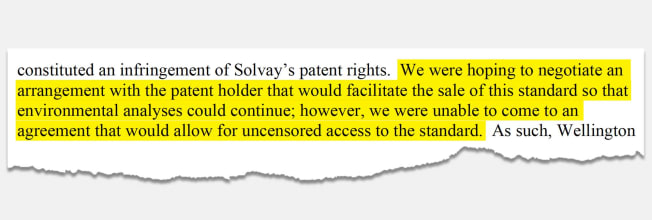Solvay Impedes Research Into Unknown PFAS by Threatening Testing Lab With Legal Action
Independent scientists must now go through the company itself in order to obtain necessary tests for unknown PFAS

A Canadian laboratory can no longer sell a crucial product that independent researchers rely upon to test and analyze whether a particular PFAS chemical is present in soil or water, after the manufacturer of the chemical—Solvay S.A.—threatened the lab with legal action, according to documents reviewed by Consumer Reports and interviews.
The lab, Canada-based Wellington Laboratories, specializes in making “analytical standards” of chemicals, essentially pure versions of compounds that scientists can use to accurately monitor the presence and concentration of a contaminant in the environment. While the work may be obscure to the general public, for scientists, it provides a necessary tool to conduct accurate research of chemicals that little may be known about. And Solvay’s action is unprecedented, according to researchers and advocates who spoke to CR.
“Solvay is trying to make it extremely difficult, if not impossible, for academic scientists to accurately measure this compound in the environment,” says Michael Hansen, Ph.D., a senior scientist at CR.

NA NA
Independent scientists and consumer advocates were outraged by Solvay’s legal maneuver, saying it represented a virtually unheard of tactic by manufacturers that will impede research into a new and emerging PFAS chemical. Under federal law, companies that use PFAS to make products—like batteries or stain-resistant clothing—can already prohibit the public release of information about the chemicals they use by claiming it's “confidential” and secret.
Indeed, Riddell says that Solvay's request marked the first time that Wellington had encountered a patent claim.
"We offer an extensive line of PFAS reference standards and have never been contacted by a industrial manufacturer regarding patent infringement before," she says.
Brian Carroll, head of external communications at Solvay, confirmed that the company became aware of Wellington’s analytical standards in early 2020 and subsequently “determined that Wellington’s offer was in violation of Solvay’s patent.”
“Solvay subsequently notified Wellington of its infringement,” Carroll says. C6O4 is manufactured by a Solvay affiliate outside of the U.S., he adds, for use in “certain specialty polymers products.”
“As a science company with sustainability at our core, Solvay meets applicable legal standards with respect to health, safety, and the environment,” he adds. “We care deeply about the well-being of our employees and the communities in which we operate.”
Highlights Secrecy Concerns
Solvay’s apparent efforts to hide information about PFAS it uses has been an ongoing source of controversy since last summer, when researchers from the Environmental Protection Agency (EPA) and New Jersey Department of Environmental Protection (NJDEP) reported finding new, potentially dangerous PFAS chemicals, first in soil samples from multiple locations in New Jersey and then in drinking water. The researchers concluded Solvay’s plant in the state was the likely source of contamination. (Solvay has denied responsibility.)
For months, CR sought safety data and studies about those PFAS—called ClPFPECA—through the Freedom of Information Act, but the EPA initially denied the request, citing Solvay’s confidentiality claims. But after CR appealed the EPA’s denial, the agency released reams of internal studies conducted by Solvay, showing the company had known of potentially severe health risks, including liver damage, with the chemicals, for years. The documents also showed that Solvay had found the PFAS in the blood of its workers.
Last month, the Environmental Working Group, an advocacy organization, called on the EPA to levy civil and criminal fines of more than $430 million against Solvay, saying the documents indicated that Solvay had for several years failed to notify the agency about company studies showing health hazards of the PFAS, as required under federal law.
Dave Andrews, EWG senior scientist, says Solvay’s action against Wellington not only hinders scientific research for one of its chemicals, but is “consistent with the company’s failure to provide EPA critical safety data.”
“It is disgraceful that Solvay is enforcing patent rights and hindering the ability of researchers to document the extent of PFAS contamination in the environment or independently study their toxicity,” he says.
C6O4
Researchers have been keen to better understand C6O4, after the compound was discovered in 2019 in a river in Italy, according to a 2020 study in Environmental Science & Technology and news reports.
The continued emergence of previously unknown PFAS has underscored the fraught debate around the safety of the chemical group. Currently, U.S. regulations governing how much PFAS can be in drinking water are limited to only a few states covering a handful of the best studied compounds.
Major manufacturers, including Solvay, have since phased out those better-studied compounds and replaced them with newer substances that companies and industry groups say are safer.
But PFAS researchers say that studies of newer PFAS suggest they pose similar risks as the older compounds, and some have called for the EPA to regulate the entire group as a “chemical class,” instead of setting limits one-by-one. The sheer breadth alone of how many PFAS exist makes it easy for companies to swap out one for another that might end up regulated.
The little research done to date about C6O4 leaves many questions unanswered about the compound’s safety.
The European Food Safety Authority (EFSA) studied the chemical’s safety in 2014 and found it’s “not of a safety concern for the consumer if the substance is only to be used as a polymer production aid” during the manufacture of fluoropolymers. The EFSA, however, said the C6O4 is intended for repeated use in contact with food.
A June 2020 study in the Journal of Endocrinological Investigation examined how C6O4 impacts thyroid cells in a test tube, calling it the first evaluation of potential adverse effects of C6O4. The study found no adverse effects, but the authors cautioned the findings “do not allow drawing firm general conclusions as to the safety of C6O4 exposure.”
Is C6O4 Being Used in the U.S.?
In response to questions from CR, Solvay spokesperson Carroll says that C6O4 is not manufactured or used by the company in the U.S., but he added a caveat: “Nor to the best of our knowledge is it manufactured or used by other companies in the U.S.”
Statements by a Solvay competitor last year raised the possibility that C6O4 might already be used in the U.S.
In a February 2020 letter to the Michigan Department of Environment, Great Lakes, and Energy (EGLE), the manufacturer Chemours provided comments about the state’s proposed drinking water standards for PFAS, which included GenX, a compound used by Chemours.
If Michigan regulators determine that water should be tested for GenX, Chemours argued, the state “should include these other short-chain processing aids as well,” including Solvay’s C6O4. (Chemours didn’t respond to a request for comment.)
The problem, experts say, is that it’s difficult, if not impossible, to know whether C6O4 is being used in the U.S.
The EPA must approve any new chemical for use in the U.S. under the Toxic Substances Control Act, says Erik Olson, senior strategic director for Health at the Natural Resources Defense Council, an environmental advocacy organization, says the EPA must approve any new chemical for use in the U.S. under the Toxic Substances Control Act. But Olson says the actual formula and name of the chemicals are often “shrouded in secrecy as supposed trade secrets.”
“This is an issue we’ve been fighting for years,” he says. “So it would be difficult to know if these chemicals are being used here.”
Can the EPA Step In?
The possibility that Solvay’s C6O4 could be used in the U.S. underscores the risks of Solvay blocking Wellington Labs from selling an analytical standard of the compound.
“This cease and desist letter from Solvay to Wellington is alarming, and if left standing it would create a dangerous precedent,” says Tom Bruton, Ph.D., senior scientist at the Green Science Policy Institute and PFAS researcher. “PFAS producers like Solvay should be providing analytical standards to researchers and regulators free of charge, but instead they're trying to block those scientists' access to the standards and slow down their work to protect public health.”
Without analytical standards, scientists could utilize a testing technique called “non-targeted analysis,” which essentially allows researchers to reverse engineer the process. That’s what EPA and New Jersey researchers used to uncover and identify Solvay’s PFAS compound, ClPFPECA.
Researchers say non-targeted analysis is crucial for identifying new PFAS compounds, but it’s a costly and time-consuming endeavor. And Solvay has called into question that testing method before. The company previously told CR such findings about Solvay and ClPFPECA are “inherently imprecise.”
“Solvay can’t have it both ways,” says CR’s Hansen. “On the one hand, the company won’t provide researchers the standard needed to examine one of its PFAS. On the other, it says you can’t trust results that don’t use that standard.”




















